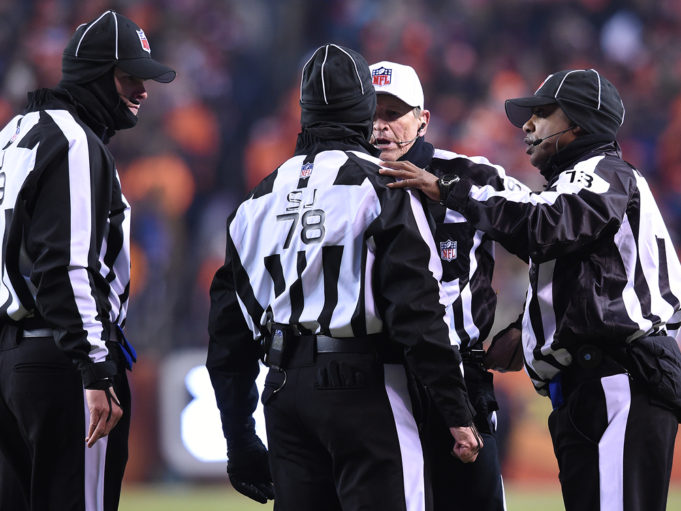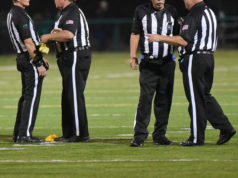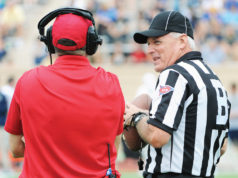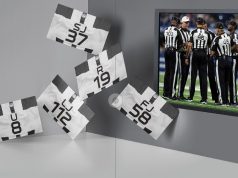Much has been written and said about the importance of perception in officiating. Image is everything, as the saying goes and that is true not only of the officials comprising a crew but the crew as a whole. Little things that crews do and fail to do can create in the minds of coaches, players and observers the belief that the crew is in command of things — or conversely, confused and perhaps in over its head.
One thing that football crews often do that can foster a negative impression is to have conferences that go on too long or involve officials with nothing useful to offer. How many times have you seen games in which multiple officials converge to discuss what may be something as simple as a false start and to prolong the discussion to the point that everyone gets antsy? To be sure, when more than one official has a flag down on a play, all of the calling officials must get together to compare notes; what I’m talking about are crew conferences when only the referee and calling official need to be involved, crew conferences that are needed but involve five people when only three have something meaningful to contribute and meetings that go on endlessly because those involved are talking over each other, too excited and the like.
If, for example, only the head linesman has a false start before the snap, he can quickly communicate that to the referee and umpire, the umpire can immediately march off the penalty and the referee can give the signal and, if applicable, microphone announcement. There doesn’t need to be any preliminary signal by the referee or any other officials involved in the discussion; in fact, there really doesn’t need to be much discussion at all. The procedure in college ball is for the linesman to give the referee a visual false start signal, which the umpire will see; all the referee needs is the player’s number (if he doesn’t already know it) and then makes an announcement while the umpire marks off the five yards. Bing, bang, done. If others besides the linesman have a flag down, they will converge with the referee and the umpire to determine whether it is a false start or defense in the neutral zone (offside). But again, they do their thing and get on with it.
The same thing applies no matter the foul(s) and number of officials with flags. We need to be sure that everyone understands what has been called and what the enforcement is, but we do it expeditiously and without officials with no flags down involved in the discussion.
If it is appropriate at whatever level you work for calling officials to give visual signals, it sure can help the referee to get things clarified and enforced with alacrity. One example is the one above, in which the linesman has a false start; his giving me the visual signal eliminates the need for a lengthy discussion. If a deep official has defensive pass interference and, after he throws his flag, he gives me the appropriate signal and points to the defense, the tumblers of my mind start immediately working. As I run downfield to meet him I already know what he has called and I can calculate whether the foul is a spot foul or we will enforce the 15 yards (because that is how interference is enforced under NCAA rules). That eliminates a lot of talk and possible confusion, saves a ton of time and helps us to look crisp and in control.
In line with that, I do not give options to the captain if the choice is clear. That wastes time. If, for example, the offense gains six yards on a running play so that it will be third and four, but there is holding in the backfield, no consultation is needed to know the defense wants the penalty enforced. Once I get the foul and its location and the number of the fouling player — the umpire will know that as he will be with me when the calling official reports that information — the umpire enforces the penalty and I give the announcement. NFHS mechanics don’t allow for that lack of consultation, but the idea is be as brief as possible.
Being thorough but expeditious helps to move the game along and creates the impression that the crew is on top of things. Contrast that with the situation in which there is a lot of discussion involving a lot of people. The referee starts to leave and do something but then he returns and there is more discussion, with officials pointing here, there and yonder until finally something is done. The reality may be that the crew knows what it is doing, but the perception will be otherwise and there can be a snowball effect with doubts cast on things the crew does or calls down the line.
Lest anyone misunderstand, let me stress that I am not advocating speed at the expense of accuracy. Sometimes conferences are necessary and it will take a while to sort things out. Ultimately, our goal has to be to get things right. I am simply saying that multi-official conferences should be held only when they are necessary; they should be reasonable in length, meaning that everyone who talks must do so calmly; and they should not involve officials with nothing to offer. If you don’t have a flag down or something meaningful to offer, stay out of it.
Having said all of that, it is essential to ensure that all of the pieces of the puzzle are put together at one time and before the referee does anything. Last season our crew had a game that began with an onside kick. On the goalline, I saw a flag from the back judge and then saw the side judge point to indicate that the receivers recovered the kick. The back judge told me he had offside on the kickers; the side judge told me he pointed the wrong way and the kickers recovered. Fine. I announced the penalty, noted there would be a rekick and ran back to the goalline. Tweet, tweet! In comes the field judge to ask why, if the receivers recovered, we’re not adding the penalty to the spot of the recovery. I told him the side judge pointed the wrong way and the kickers recovered. Off goes the field judge, only to tweet, tweet and come running in again to ask whether the kick went 10 yards or the receivers should get it at the spot of illegal touching. That meant I had to get the side judge involved to ask him about that; he said it did go 10 yards.
When we finally rekicked, with 14:55 on the clock in the first quarter, we had pretty well convinced the two coaches that we had no clue what we were doing. The Keystone Cops looked more organized and in command than we did.
First, kudos to the field judge. My rule is that even if you’re the one guy on the crew who thinks something is not right, stop the game and ask the question, for you may save the entire crew from disaster. But my main point is that we did not take our time from the start to be sure we had all the necessary information assembled and that all of us were on the same page before anyone enforced or announced anything. The play was a little confusing andthere was a lot going on, but there is no excuse for it having led to all of the discussions, meetings, etc., that ensued.
The next time you work a game, spend time in the pregame discussing the notion of having conferences only if clearly needed, limiting them to the people with relevant input to offer, having people talk calmly and not over one another and ensuring that discussions end with all pieces of the puzzle put together and all crew members singing from the same song sheet. Handling business in an expeditious, crisp and organized fashion will go a long way toward creating the impression that the crew knows what it, is doing, which can save its bacon when the tough times come.
What's Your Call? Leave a Comment:
Note: This article is archival in nature. Rules, interpretations, mechanics, philosophies and other information may or may not be correct for the current year.
This article is the copyright of ©Referee Enterprises, Inc., and may not be republished in whole or in part online, in print or in any capacity without expressed written permission from Referee. The article is made available for educational use by individuals.


















